Rambler (automobile)
Rambler was an automobile brand name used by the Thomas B. Jeffery Company between 1900 and 1914, then by its successor, Nash Motors from 1950 to 1954, and finally by Nash's successor, American Motors Corporation from 1954 to 1969 in the United States and 1983 in international markets. It was often nicknamed the "Kenosha Cadillac" after its place of manufacture.[1]

1897–1914
The first use of the name Rambler for an American made automobile dates to 1897 when Thomas B. Jeffery of Chicago, Illinois and builder of the Rambler bicycle, constructed his first prototype automobile.
After receiving positive reviews at the 1899 Chicago International Exhibition & Tournament and the first National Automobile Show in New York City, Jeffery decided to enter the automobile business. In 1900, he bought the old Sterling Bicycle Co. factory in Kenosha, Wisconsin, and set up shop.
Jeffery started commercially mass-producing automobiles in 1902 and by the end of the year had produced 1,500 motorcars, one-sixth of all existing in the USA at the time. The Thomas B. Jeffery Company was the second largest auto manufacturer at that time, (behind Oldsmobile).
Rambler experimented with such early technical innovations as a steering wheel (as opposed to a tiller), but it was decided that such features were too advanced for the motoring public of the day, so the first production Ramblers were tiller-steered. Rambler innovated various design features and was the first to equip cars with a spare wheel-and-tire assembly. This allowed the driver, when experiencing a common puncture (flat tires) to exchange the spare wheel & tire for the flat one.
In 1914, Charles T. Jeffery, Thomas B. Jeffery's son, replaced the Rambler brand name with Jeffery in honor of his now deceased father.
In 1916, the Thomas B. Jeffery Company was purchased by Charles W. Nash and became Nash Motors Company in 1917. The Jeffery brand name was dropped at the time of the sale and the manufacture of Nash branded automobiles commenced. In 1937, the concern became the Nash-Kelvinator Corporation through a merger with the well-known appliance maker.
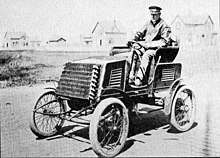 Thomas Jeffery in his first prototype Rambler motor vehicle 1901
Thomas Jeffery in his first prototype Rambler motor vehicle 1901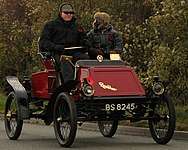 Rambler 6HP Runabout 1903
Rambler 6HP Runabout 1903 Rambler 6 1/2HP Runabout 1903
Rambler 6 1/2HP Runabout 1903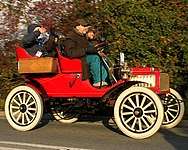 Rambler 7HP Rear-entrance tonneau 1904
Rambler 7HP Rear-entrance tonneau 1904 1908 Rambler advertisement
1908 Rambler advertisement- 1913 Rambler five-passenger touring car
1950–1957
Under the direction of Charles Nash's successor George W. Mason, Nash-Kelvinator Corporation began development of a small car that could be produced inexpensively for the post World War II economy.
However, steel shortages limited the amount of raw materials that Nash could get, so Mason turned the compact, now designated the Rambler, into a two-door sedan with a convertible top and the cars were equipped with many standard features that were typically options, to maximize profits for the company. When introduced, the Rambler was an immediate success for Nash. As steel quotas (related to the Korean War) eased, the Rambler line was broadened in both its model types (first a station wagon and 2-door hardtop dubbed "Country Club", and later a 2-door sedan. A further expansion of the line for 1954 included a four-door sedan and station wagon called "Cross Country") on a stretched wheelbase, which proved to be as successful as the first generation of two-door sedan convertibles.
The first generation of modern Ramblers carried a modified version of Nash's Airflyte styling, which included closed wheel openings. Where the wheel openings of any car are a major source of wind resistance, the design was rather primarily an engineering design to increase the strength of the car for impact resistance. Many people surmised that the skirted fenders limited the turning radius of the wheels but was not an actual handicap for having a comparatively narrow front track. Ramblers continued to use this styling until 1955, when the front wheels were revealed by a periodic design update. In 1954 the Rambler offered the first industry combination heating and air conditioning unit that could be an add-on or installed at the factory for $395.00, which at that time was about the lowest cost unit available in an American car.[2]
In 1954, American Motors Corporation (AMC) was formed from the merger of Nash-Kelvinator and the Hudson Motor Car Company. Following the merger, 1955 and 1956 Ramblers were badged as both Nashes and Hudsons, with no visible difference between the two. Rambler became a marque in its own right for the 1957 model year. The Nash and Hudson makes were continued as senior model only through 1957, after which all of AMC's offerings were marketed as Ramblers, with the exception of the imported 1958–1962 Metropolitan.
.jpg) 1951 Nash Rambler Custom two-door sedan
1951 Nash Rambler Custom two-door sedan.jpg) 1951 Nash Rambler Deliveryman
1951 Nash Rambler Deliveryman 1952 Nash Rambler wagon
1952 Nash Rambler wagon 1954 Nash Rambler Custom Country Club
1954 Nash Rambler Custom Country Club.jpg) 1955 Rambler Country Club, made by American Motors Corporation
1955 Rambler Country Club, made by American Motors Corporation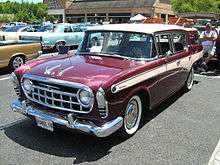 1957 Rambler Custom Cross-Country wagon
1957 Rambler Custom Cross-Country wagon
1958–1969
At the start of the 1960s George Romney made a marketing decision that more fully unified the various Rambler model names under the Rambler brand. In 1962, the Ambassador, a top-trim level model, was officially brought under the Rambler name (it had previously been named the "Ambassador by Rambler"), and the former Rambler Six and Rambler Rebel V8 were renamed the Rambler Classic. (Note: while the top-line models for 1958-1961 were advertised as the "Ambassador V-8 by Rambler", on the cars themselves, the nomenclature was "Rambler Ambassador".) Back in 1958, AMC introduced America's first "compact car," the Rambler American. This car was essentially the 1950 Nash Rambler, slightly restyled and modernized for the late 1950s. However the car was an instant success and lost sales only after the "Big Three" (GM, Ford, and Chrysler) each introduced compact cars of their own (GM "X" body, Ford Falcon, Chrysler A platform).
Romney also put into play his plan to slash production costs, which involved more common parts sharing between the Ambassador and Classic models. Beginning in 1962, all "senior" Rambler models would share the same automobile platform with identical wheelbase and body parts, but the engines, trims, and equipment levels distinguished the Classic from the Ambassador. The Rambler's compact size (by US standards) also made it an international competitor, and between 1961 and 1965 AMC opened thirteen foreign assembly plants, from Costa Rica to the Philippines.[3]
In 1963, the entire Rambler line received the Motor Trend Car of the Year award. However, Romney's departure to become Michigan governor opened the door for his successor, Roy Abernethy, to redirect the company towards a strategy of competing head to head with the Big Three (General Motors, Chrysler Corporation, and Ford Motor Company) with a variety of bodies and automobile platforms. This new plan also included marketing the various models apart from the Rambler brand name, which Abernethy felt would be a hindrance in the market segments he hoped to pursue.
One of the first moves in that direction was the creation of the 1965 line of Ramblers, which split the Classic from the Ambassador visually, while still sharing a significant number of parts. Once again the Ambassador had a unique, extended wheelbase. In addition, AMC introduced the Marlin, a hardtop coupe intended to give AMC a toe-hold in the sporty fastback market while also functioning as a "halo" vehicle.[3] AMC chief stylist Richard Teague introduced a totally restyled and attractive Rambler American in 1964, which was a sales success. This basic body remained in its original shape through 1969.
Backed by marketing reports, Abernethy next made a persuasive argument to the AMC board that the Rambler name had not only acquired a stodgy image and was a hindrance to increasing sales, but that consumers associated it with compact cars. In what hindsight would show to be an ill-conceived decision, American Motors began to phase it out in favor of an AMC marque beginning in 1966, as it attempted to become a multiplatform automobile manufacturer. Retention of the well-known Rambler brand name and its association with compact economy models could have served AMC well in the 1970s.
By 1968, the only vehicle produced by AMC to carry the Rambler marque was the compact Rambler American. Although designed as a no-nonsense economy car, the American spawned the audacious SC/Rambler developed with Hurst Performance.[4] While AMC planned to produce only 500 for the 1969 model year, the "Scrambler" proved so popular two more groups of about 500 each were built.[5] All featured the same 390 cu in (6.4 l) V8, four-barrel carburetor, and close-ratio four-speed transmission of the AMX, plus Hurst shifter, Twin-Grip (limited slip) differential, and cold air hood.[5] For the final year in 1969 the models were simply called Rambler. The 1969 Rambler (and Chevrolet Corvair and Dodge Dart) were the only U.S. compact cars available that year in a two-door hardtop body style; Ford compacts were only available as sedans.
The last U.S. built Rambler was produced on 30 June 1969, and it was one of over 4.2 million cars to carry the Rambler name that rolled off the assembly line in Kenosha.[4]
 1958 Rambler sedan
1958 Rambler sedan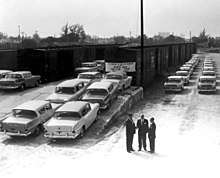 Train unloading 1958 Ramblers for a car rental company in Florida.
Train unloading 1958 Ramblers for a car rental company in Florida.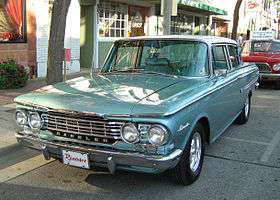 1962 Rambler Ambassador, AMC's largest model
1962 Rambler Ambassador, AMC's largest model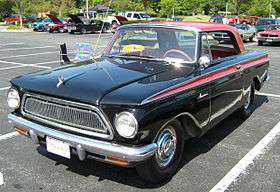 1963 Rambler American 440 2-door hardtop
1963 Rambler American 440 2-door hardtop 1964 Rambler Classic 770 wagon
1964 Rambler Classic 770 wagon- 1966 Rambler Ambassador 990 convertible
 1967 Rambler Rebel 770 sedan
1967 Rambler Rebel 770 sedan
1970–1983
The Rambler marque was continued in all international markets after it was dropped in the United States. AMC vehicles were badged as “Rambler" in Argentina, Australia, Costa Rica, Mexico, New Zealand, Philippines, Venezuela, South Africa, and United Kingdom. In Argentina, a special model based on the third generation Rambler American became the IKA Torino in 1967. It later was named the Renault Torino and was offered until 1981. The Rambler nameplate was last used on automobiles in 1983 by Vehículos Automotores Mexicanos (VAM) in Mexico.
Rambler brand cars
- Historic
- Rambler: 1901–1913
- Compact
- Rambler American: 1958–1968
- Rambler 1969
- Mid-sized
- Rambler Six and V8: 1957–1960
- Rambler Rebel: 1957–1960
- Rambler Ambassador: 1958–1965
- Rambler Classic: 1961–1966
- Rambler Typhoon: 1964
- Rambler Rebel: 1967
- Rambler Marlin: 1965
- Show cars
- Rambler Palm Beach: 1950
- Rambler Tarpon: 1964
- International
- Rambler Ambassador
- Costa Rica 1965-1970
- United Kingdom 1965-1974
- Rambler AMX
- Australia 1969–1970[6]
- Rambler Hornet
- Australia 1970–1975[7]
- Costa Rica 1970-1975 (as "Rambler SST" and "Rambler Unisex")
- Mexico 1970-1977 (as "VAM American" and "Rambler American")
- South Africa 1970-1971
- Rambler Javelin
- Australia 1968–1973[7]
- Germany 1968-1970
- Mexico 1968-1973
- Venezuela 1968-1974
- Philippines 1968-1970.
- Rambler Matador
- Australia 1971–1977[7]
- Costa Rica 1971-1974
- Mexico 1971-1976 (as "Rambler Classic")
- United Kingdom 1971-1977
- Rambler Rebel
- Australia 1967–1971[8]
- Belgium 1967 (as "Renault Rambler")
- Costa Rica 1967-1970
- Mexico 1967-1970 (as "Rambler Classic.")
- New Zealand 1967-1971
- United Kingdom 1967-1970
International production
.jpg) 1964 Rambler Classic 660 built by Campbell Motor Industries, New Zealand.
1964 Rambler Classic 660 built by Campbell Motor Industries, New Zealand.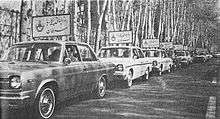 Sherkate Sahami Jeep company built the 1966 Rambler American from 1967-1974 in Iran.
Sherkate Sahami Jeep company built the 1966 Rambler American from 1967-1974 in Iran.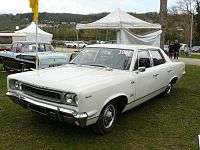 1967 Renault Rambler sedan, built by Renault, Belgium.
1967 Renault Rambler sedan, built by Renault, Belgium..jpg) 1975 Rambler Hornet built by Australian Motor Industries, Australia.
1975 Rambler Hornet built by Australian Motor Industries, Australia..jpg) 1976 Australian-assembled Rambler Matador (U.S 1974 model)
1976 Australian-assembled Rambler Matador (U.S 1974 model)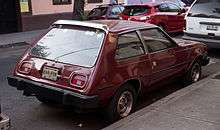 AMC Gremlin made by Vehículos Automotores Mexicanos, Mexico.
AMC Gremlin made by Vehículos Automotores Mexicanos, Mexico..jpg) New Zealand-assembled 1970 Rambler Rebel.
New Zealand-assembled 1970 Rambler Rebel.
Companies which undertook the production of Rambler vehicles outside of the United States either by local assembly or full import included the following:
North America
- Vehículos Automotores Mexicanos (Mexico): 1963–1983
- Purdy Motor (Costa Rica): 1964-1973
- Motorizada de Costa Rica (Costa Rica): 1974-1978[9]
- Nassau Motors (Bahamas): 196?-197?[10]
Australasia
- Australian Motor Industries (Australia): 1960–1977
- VW Motors Ltd (New Zealand): 1958-1962
- Campbell Motor Industries (New Zealand): 1964–1971
- Luzon Machineries Limited (Philippines): 196?-1970
Europe
- Renault (France/Belgium): 1962-1967
- Jacques Poch (France): 1970s
- Jean-Charles (France): 1970s
- Rambler Motors (A.M.C) Limited (United Kingdom): 1961-1977[11]
- Wilhelm Karmann GmbH (Germany): 1968-1970
- Kolberg & Caspary AS (Norway): 1958-19??
South America
- Constructora Venezolana de Vehículos (Venezuela): 1968–1974
- Industrias Kaiser Argentina (Argentina): 1962–1972
- Industria Automotriz Peruana SA (Peru): 196?-1970[12]
Africa
- National Motor Assemblers (South Africa): 1964-1967
- Rosslyn Motor Assemblers (South Africa): 1968
- Motor Assemblies Limited (South Africa): 1969-1970[13]
Middle East
- Pars Khodro (Iran): 1967-1974
References
- Inline
- "What is Kenosha Cadillac? - Automotive dictionary and encyklopedia - all about cars, motorcycles, engines etc". CarSpector. 2008. Retrieved 27 February 2011.
- "Nash Low Cost Air Conditioner Cools or Heats by Turning Knob." Popular Mechanics, May 1954, p. 86.
- Billeter, Vera (1965), Logoz, Arthur (ed.), "The American Motors Story", Auto-Universum 1966 (English edition), Zürich, Switzerland: Verlag International Automobile Parade, IX: 18–19
- Binder, Al; the Ward's staff (1 June 2002). "Rearview Mirror". Ward's AutoWorld. Retrieved 27 February 2011.
- Flory, J. Kelly (2004). American Cars, 1960–1972: Every Model, Year by Year. McFarland. p. 633. ISBN 978-0-7864-1273-0.
- "Australian Motor Industries AMX". amx-perience.com. Archived from the original on 14 August 2014. Retrieved 17 May 2014.
- Green Price and Model Guide, July-August 1983, page 74
- Glass's Dealer Guide, South Australian and Northern Territory Edition, Jun 1973, page 95
- http://amc.co.cr/amc_costarica.htm
- https://ufdcimages.uflib.ufl.edu/UF/00/08/42/49/03303/00214.jpg
- https://www.gracesguide.co.uk/1961_Guide_to_Key_British_Enterprises:_Motor,_Motor-Cycle_and_Commercial_Vehicle_Manufacturers
- http://www.arkivperu.com/rambler-del-peru-1969/
- http://motor-assemblies.blogspot.com/2012/01/motor-assemblies-limited.html?m=1#appendixb
- General
- Gunnell, John, ed. (1987). The Standard Catalog of American Cars 1946–1975. Krause Publications. ISBN 978-0-87341-096-0.
